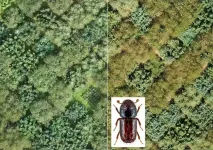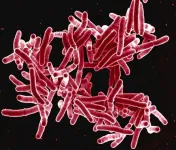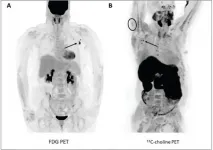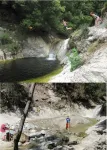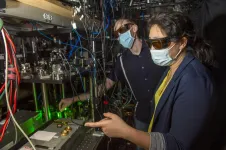Study on bizarre rodent genetics solves a mystery and reveals another
2021-05-19
(Press-News.org) Open up Scott Roy's Twitter bio and you'll see a simple but revealing sentence: "The more I learn the more I'm confused." Now the rest of the scientific world can share in his confusion. The San Francisco State University associate professor of Biology's most recent research, published earlier this month in one of the scientific world's most prestigious journals, catalogues a strange and confounding system of genes in a tiny rodent that scientists have ignored for decades.
"This is basically the weirdest sex chromosome system known to science," Roy said. "Nobody ordered this." But he's serving it anyway.
The owner of those chromosomes is the creeping vole, a burrowing rodent native to the Pacific Northwest. Scientists have known since the '60s that the species had some odd genes: Their number of X and Y chromosomes (bundles of DNA that play a large role in determining sex) is off from what's expected in male and female mammals.
That finding caught Roy's eye when presented by a guest speaker at a San Francisco State seminar, and he realized that modern technology might be able to shed new light on the mysteries hiding in the voles' DNA. After working with collaborators to disentangle the voles' genetic history -- resulting in one of the most completely sequenced mammal genomes that exists, according to Roy -- the story only got stranger.
The team found that the X and Y chromosomes had fused somewhere in the rodents' past, and that the X chromosome in males started looking and acting like a Y chromosome. The numbers of X chromosomes in male and female voles changed too, along with smaller pieces of DNA getting swapped between them. The researchers published their results in Science on May 7.
Drastic genetic changes like these are exceptionally rare: The way genes determine sex in mammals has stayed mostly the same for about 180 million years, Roy explains. "Mammals, with few exceptions, are kind of boring," he said. "Previously we would have thought something like this is impossible."
So how did the genes of this unassuming rodent end up so jumbled? It's not an easy question to answer, especially since evolution is bound to produce some strangeness simply by chance. Roy, however, is determined to figure out the "why." He suspects that what the team found in the vole's genome is something like the aftermath of an evolutionary battle for dominance between the X and Y chromosome.
The research couldn't have happened, Roy says, without collaborations with Oregon fish and wildlife biologists who had a creeping vole sample sitting in a lab freezer. He also teamed up with a group from Oklahoma State University when the two groups started chatting about creeping vole DNA sequences that were posted on the internet -- and both realized they were working on the same question.
Another key was working at a teaching-focused institution. Roy says he has the time to develop ideas with colleagues and students at SF State, and he can do research where he doesn't quite know what he'll find. "This is a great example of non-hypothesis-based biology," Roy explained. "The hypothesis was, 'This system is interesting. I bet if you looked into it some more, there'd be other interesting things.'"
It won't be the last time Roy's lab goes out on a limb. He and his collaborators plan to look into the genomes of other species related to the voles to chart the evolutionary path that led to this strange system. He'll also continue DNA sequencing curiosities across the tree of life.
"These bizarre systems give us a handhold to start to understand why the more common systems are the way they are and why our biology works as it does," he explained. By delving into the weirdest that nature has to offer, maybe we can come to understand ourselves better, too.
INFORMATION:
ELSE PRESS RELEASES FROM THIS DATE:
2021-05-19
In recent years, foresters have been able to observe it up close: First, prolonged drought weakens the trees, then bark beetles and other pests attack. While healthy trees keep the invaders away with resin, stressed ones are virtually defenseless. Freiburg scientist Sylvie Berthelot and her team of researchers from the Faculty of Environment and Natural Resources and the Faculty of Biology are studying the importance of tree diversity on bark beetle infestation. They are investigating whether the composition of tree species affects bark beetle feeding behavior. The team recently published their findings in the Journal of Ecology.
In a 1.1 hectare experimental set-up in Freiburg, six native deciduous and coniferous tree species from Europe and six deciduous and coniferous ...
2021-05-19
SAN ANTONIO (May 19, 2021) -- Four months of multi-drug therapy that included rifapentine and moxifloxacin treated active tuberculosis (TB) as effectively as the standard six-month regimen in a multinational study, cutting treatment time by a third. Coauthors including Marc Weiner, MD, of The University of Texas Health Science Center at San Antonio, reported the findings May 6 in the New England Journal of Medicine.
"Shorter treatment would be easier for people to complete without missing doses, and ultimately may be cost-effective," said Dr. Weiner, associate professor in the health science center's Joe R. and Teresa Lozano END ...
2021-05-19
A team of researchers at the Centre Spatial de Liège (CSL) of the University of Liège has just developed a method to identify the contributors and origins of stray light on space telescopes. This is a major advance in the field of space engineering that will help in the acquisition of even finer space images and the development of increasingly efficient space instruments. This study has just been published in the journal Scientific Reports.
Space telescopes are becoming more and more powerful. Technological developments in recent years have made it possible, for example, to observe objects further and further into the universe or to measure the composition of the Earth's atmosphere with ever greater precision. However, there is still one factor limiting the performance ...
2021-05-19
HAMILTON, ON (May 19, 2021) - Researchers have found that the inclusion of a third drug to commonly used dual-drug inhalers can reduce asthma exacerbations and improve control over the disease in children, adolescents, and adults with moderate-to-severe asthma.
A team from McMaster University and The Research Institute of St. Joe's Hamilton announced their findings from a systematic review and meta-analysis. Data from 20 randomized controlled trials, which included a total of almost 12,000 patients, were analyzed in the study.
Dual-drug inhalers used to treat asthma typically contain an inhaled corticosteroid (ICS) to reduce inflammation, as well as a long-acting beta-adrenoceptor agonist (LABA) that acts as a bronchodilator. High-certainty evidence showed that the inclusion of a third ...
2021-05-19
Leesburg, VA, May 19, 2021--According to an open-access article in ARRS' American Journal of Roentgenology (AJR), increased axillary lymph node or ipsilateral deltoid uptake is occasionally observed on FDG or 11C-choline PET performed after Pfizer-BioNTech or Moderna COVID-19 vaccination.
"Recognition of occasional abnormal axillary lymph node or deltoid uptake on PET examinations performed after COVID-19 vaccination will aid interpreting physicians and reduce unnecessary biopsies," wrote corresponding author Jason R. Young from the department of radiology at Mayo Clinic in Rochester, MN.
Young and colleagues' retrospective study included ...
2021-05-19
For the first time, geological records have been used to reconstruct the history of Larsen C Ice Shelf in Antarctica. The ice shelf is the largest remaining remnant of a much more extensive area of ice on the Antarctic Peninsula that began to break up during the 1990s (Larsen A), and saw a huge collapse in 2002 (Larsen B). This new reconstruction enables scientists to better understand if and when the remaining ice shelf could collapse in the future.
Publishing this month in the journal Geology an international team describes how the largest remaining ice shelf on the Antarctic ...
2021-05-19
By mapping its genetic underpinnings, researchers at University of California San Diego School of Medicine have identified a predictive causal role for specific cell types in type 1 diabetes, a condition that affects more than 1.6 million Americans.
The findings are published in the May 19, 2021 online issue of Nature.
Type 1 diabetes is a complex autoimmune disease characterized by the impairment and loss of insulin-producing pancreatic beta cells and subsequent hyperglycemia (high blood sugar), which is damaging to the body and can cause other serious health problems, such as heart disease and vision loss. Type 1 is less common than type 2 diabetes, but its prevalence is growing. The U.S. Centers for Disease ...
2021-05-19
Boulder, Colo., USA: Deep pools below waterfalls are popular recreational swimming spots, but sometimes they can be partially or completely filled with sediment. New research showed how and why pools at the base of waterfalls, known as plunge pools, go through natural cycles of sediment fill and evacuation. Beyond impacting your favorite swimming hole, plunge pools also serve important ecologic and geologic functions. Deep pools are refuges for fish and other aquatic animals in summer months when water temperatures in shallow rivers can reach lethal levels. Waterfalls also can liquefy sediment within the pool, potentially triggering debris flows that can damage property and threaten ...
2021-05-19
Florida State University researchers have more insight into a strange sea creature found in oceans around the world and what their presence means for the health of a marine ecosystem.
Scientists have thought that salps -- small marine organisms that look like clear, gelatinous blobs -- competed for resources with krill, shrimp-like creatures that are an important food source for many marine animals. But new research published in Limnology and Oceanography suggests that salps are actually competing for food with an organism known as a protist.
An image of a salp taken during research. New research published in Limnology and Oceanography suggests that salps are actually competing for food with an organism known as a protist. (Courtesy of ...
2021-05-19
A heart surgeon doesn't need to grasp quantum mechanics to perform successful operations. Even chemists don't always need to know these fundamental principles to study chemical reactions. But for Kang-Kuen Ni, the Morris Kahn associate professor of chemistry and chemical biology and of physics, quantum spelunking is, like space exploration, a quest to discover a vast and mysterious new realm.
Today, much of quantum mechanics is explained by Schrödinger's equation, a kind of master theory that governs the properties of everything on Earth. "Even though ...
LAST 30 PRESS RELEASES:
[Press-News.org] Study on bizarre rodent genetics solves a mystery and reveals another
